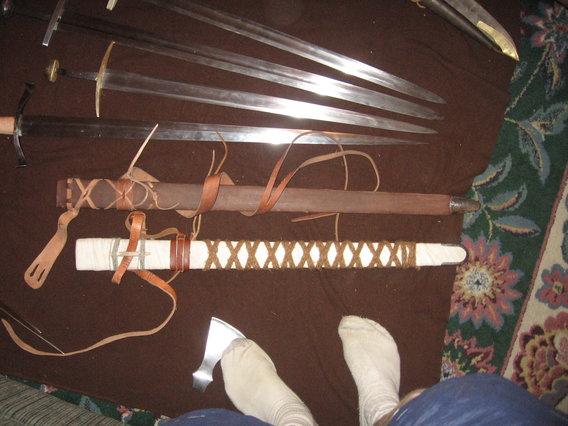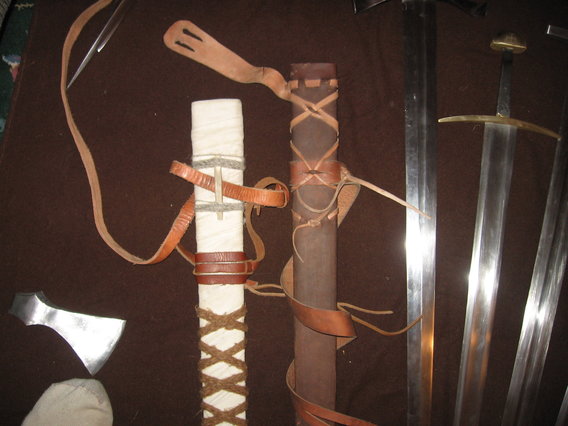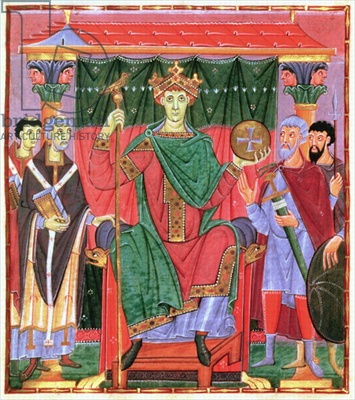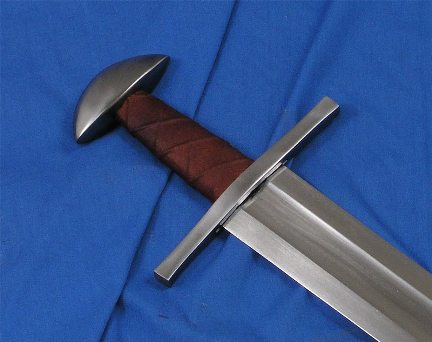Hello folks,
I've been doing research into Ottonian material culture to put some backdrop to my studies, and realize that I know very little about continental swords around the turn of the millennium. Anyone have any examples of surviving swords from this period and from Germany to share? Thanks!
-Gregory
Geibigs "Beiträge zur morphologischen Entwicklung des Schwertes im Mittelalter" is full of German swords, many from Ottonian times. Most are of types that can be seen in Petersens work, especially Oakeshotte type X, Xa and XI blades with Petersen type M, X and Y hilts, with a very few R,S and O. The earlier swords (8th-9th C) are more disttinct from those seen in Norway, a sort of Petersen type H with a much more rounded pommel shape, very short, deep lower guards and broad, parallel edged blades with very round points. I am actually working on a reenacting kit for an Ottonian warrior, so I am really interested in learning more about material culture from this time and place too.
Hey Scott,
Thanks for the reply. I'm also toying with the idea of doing an Ottonian impression, probably from the reign of Henry II, reflecting a warrior who would have fought in the Imperial wars against Poland. I primarily study later German social history (Hohenstaufen) but I really can't afford a kit of the quality I demand from that late period when a full mail harness is expected. Moving back to simpler times will give me the opportunity I need to purchase and build quality replicas for my panoply.
I'm terrible about buying books on weaponry. Too many social history books on my wish list as it is! I see that Geibig's book is rather rare and expensive, so I can't imagine purchasing it any time soon. I'll have to take the time to get some of Oakeshott's basic works and also pick up a copy of Petersen's book. I see the one focusing on Norwegian swords - is there another that has more continental material, or is that the one to get?
Looking at Albion's Next Generation swords, it seems like the Stamford might be one of the more appropriate models to consider for such a cause? What's your take on their line up and possibilities for Ottonian swords? Do any other production swords come to mind? Thanks again, 'n cheers!
-Gregory
(EDIT: Said "Museum Line" instead of "Next Generation" when referring to Albion's swords. My mistake!)
Thanks for the reply. I'm also toying with the idea of doing an Ottonian impression, probably from the reign of Henry II, reflecting a warrior who would have fought in the Imperial wars against Poland. I primarily study later German social history (Hohenstaufen) but I really can't afford a kit of the quality I demand from that late period when a full mail harness is expected. Moving back to simpler times will give me the opportunity I need to purchase and build quality replicas for my panoply.
I'm terrible about buying books on weaponry. Too many social history books on my wish list as it is! I see that Geibig's book is rather rare and expensive, so I can't imagine purchasing it any time soon. I'll have to take the time to get some of Oakeshott's basic works and also pick up a copy of Petersen's book. I see the one focusing on Norwegian swords - is there another that has more continental material, or is that the one to get?
Looking at Albion's Next Generation swords, it seems like the Stamford might be one of the more appropriate models to consider for such a cause? What's your take on their line up and possibilities for Ottonian swords? Do any other production swords come to mind? Thanks again, 'n cheers!
-Gregory
(EDIT: Said "Museum Line" instead of "Next Generation" when referring to Albion's swords. My mistake!)
Last edited by Gregory J. Liebau on Fri 14 Dec, 2012 10:53 pm; edited 1 time in total
I would say that the Gaddhjalt, Stamford and Reeve would be your best bet. The Huskarl type S would be placed in the earlier part of the timespan you mentioned, while the Norman and Senlac would fit in at the very end. All of these are NG, not Museum Line, none of the Museum Line swords are early enough.
Petersen deals purely with Norwegian material. Kazavecius covers swords in the Baltic. http://www.club-kaup.narod.ru/kaup_r_kazakevicius00_orig.html If you are planning an Ottonian impression in Poland then the latter will probably be more helpful.
Here is an old picture of my sword before it was completed. I used a Hanwei Great Sword of War blade as the blank. The main inspirations were NM11840 in Helsinki, a similar sword illustrated by Kirpichnikov from Russia, and a number of swords in Geibig that have very rounded versions of Oakeshott type B pommels. The short Oakeshott style 3 cross shows a Baltic influence. My goal was to build a long and heavy cavalry sword showing a mixture of German and Baltic characteristics, from around 1050-1120 (or as early as 950 if I consider it close enough to NM11840.)
 Attachment: 32.79 KB
Attachment: 32.79 KB

Petersen deals purely with Norwegian material. Kazavecius covers swords in the Baltic. http://www.club-kaup.narod.ru/kaup_r_kazakevicius00_orig.html If you are planning an Ottonian impression in Poland then the latter will probably be more helpful.
Here is an old picture of my sword before it was completed. I used a Hanwei Great Sword of War blade as the blank. The main inspirations were NM11840 in Helsinki, a similar sword illustrated by Kirpichnikov from Russia, and a number of swords in Geibig that have very rounded versions of Oakeshott type B pommels. The short Oakeshott style 3 cross shows a Baltic influence. My goal was to build a long and heavy cavalry sword showing a mixture of German and Baltic characteristics, from around 1050-1120 (or as early as 950 if I consider it close enough to NM11840.)

Very neat stuff, Scott. Sorry about the mistaken reference to the Albions - obviously I meant to say Next Generation, woops! Thanks for the link to Kazavecius's work. I'll spend some time looking through that this weekend. As you know, Henry II did quite a bit of campaigning in his time and bounced around between Poland and Italy near the middle of his reign. I would more or less like to go for as much of a "German" feel as I can with this project. Of course, as a campaigner traveling with the imperial army, the chances to purchase nifty bits of accoutrement or even completely new armament would have been plenty. I'm certain that Kazavecius's work will have some stuff to drool over to help 'personalize' my imaginings.
I'm glad you mentioned The Reeve as well. Another neat looking sword that I was eying. I don't much care for the Gaddhjalt, though. It at first seems too typical, while being just the opposite, upon inspection. A strange sword!
Do you have any pictures of your completed sword? It looks great mocked up as it is in that photo. Is it completed yet? A beastly blade for the period you're aiming for, I'd reckon! What sort of scabbard do you have or do you plan to use with it? I haven't started researching scabbard details yet for the period, either. Considering that's a project I'd certainly take upon myself to build, can't really start collecting data too early! Cheers.
-Gregory
I'm glad you mentioned The Reeve as well. Another neat looking sword that I was eying. I don't much care for the Gaddhjalt, though. It at first seems too typical, while being just the opposite, upon inspection. A strange sword!
Do you have any pictures of your completed sword? It looks great mocked up as it is in that photo. Is it completed yet? A beastly blade for the period you're aiming for, I'd reckon! What sort of scabbard do you have or do you plan to use with it? I haven't started researching scabbard details yet for the period, either. Considering that's a project I'd certainly take upon myself to build, can't really start collecting data too early! Cheers.
-Gregory
Yes, the sword is finished, I'll try to get some photos soon. For now I am using the H-T GSOW scabbard for it. I removed the mouth locket, cut the fiberglass core back a bit and folded and glued the leather covering into the mouth. I then made some slices in the leather cover and laced a belt into it. I have some maple and pig skin for a permanent sheath. I just need to make a good period chape. The sword is indeed very long and has considerable blade presence, but it barely weighs 3lbs and is actually a lot more nimble than my Hanwei practical viking sword, despite being 6" longer. The blade has a complex distal taper and becomes very thin past the fuller. COG is about 6".
I am interested to hear more of your thoughts on the Reeve and Gaddhjalt. In what way do you find the Gaddhjalt strange? That was my top pick for a NG sword if I could afford one and was one of my main inspirations for my cavalry sword project.
 Attachment: 63.06 KB
Attachment: 63.06 KB

 Attachment: 52.51 KB
Attachment: 52.51 KB

I am interested to hear more of your thoughts on the Reeve and Gaddhjalt. In what way do you find the Gaddhjalt strange? That was my top pick for a NG sword if I could afford one and was one of my main inspirations for my cavalry sword project.


Hey Scott, thanks for the additional pictures and details. I found some decent Ottonian depictions of soldiers in painted works, mainly from the Codex Egberti (mid-10th century) and Codex Aureus (mid-11th century) but still only have one solid reference to a scabbard, which is shown in the hand of a fellow and has a rather simplistic, double-strung setup for the belt. It's a depiction of Otto III and apparently comes from the last decade of the 10th century. Seems reasonable enough. I've attached the image for reference. Interesting stuff.
A quick caveat on the sources mentioned, which I'm sure you've mulled over. Certainly, Ottonian art was greatly influenced by Byzantine schools of art, but I think the parallels in stylistic depictions between various sources is enough to say that even if stuff looks rather eastern, it was probably because eastern influences had already penetrated the empire physically, rather than just being artistic convention. What are your thoughts on this matter? It seems to be of grave importance for getting the clothing correct, particularly.
As far as my take on the Gaddhjalt and Reeve, I just made mention of my personal impressions of the swords. The Gaddhjalt has that notably Scandinavian 'spike' hilt which may not be recognizable as such at a glance. It leaps out to me as a rather typical Norman sword until that detail is noted, which is why I mentioned it as being 'strange.' I really like the Reeve but because of the brazil nut pommel (same with the Gaddhjalt, too) I think it's a sword that can easily be mistook as representative of the period proceeding from the Ottonian dynasty. I am drawn to the Stamford because it harkens more or less precisely to the decades I'm interested in.
Cheers!
-Gregory
(p.s. Oddly, I can surely admit that the sword in the hand of the fellow in the attached image looks a lot like the Gaddhjalt!)
 Attachment: 97.37 KB
Attachment: 97.37 KB

A quick caveat on the sources mentioned, which I'm sure you've mulled over. Certainly, Ottonian art was greatly influenced by Byzantine schools of art, but I think the parallels in stylistic depictions between various sources is enough to say that even if stuff looks rather eastern, it was probably because eastern influences had already penetrated the empire physically, rather than just being artistic convention. What are your thoughts on this matter? It seems to be of grave importance for getting the clothing correct, particularly.
As far as my take on the Gaddhjalt and Reeve, I just made mention of my personal impressions of the swords. The Gaddhjalt has that notably Scandinavian 'spike' hilt which may not be recognizable as such at a glance. It leaps out to me as a rather typical Norman sword until that detail is noted, which is why I mentioned it as being 'strange.' I really like the Reeve but because of the brazil nut pommel (same with the Gaddhjalt, too) I think it's a sword that can easily be mistook as representative of the period proceeding from the Ottonian dynasty. I am drawn to the Stamford because it harkens more or less precisely to the decades I'm interested in.
Cheers!
-Gregory
(p.s. Oddly, I can surely admit that the sword in the hand of the fellow in the attached image looks a lot like the Gaddhjalt!)

For a number of reasons that I don't have time or energy to enumerate at the moment, I think that that manuscript illumination is perfectly trustworthy when it comes to clothing and weapons. The costume of the man holding the sword is pretty much exactly what I am going for, a woolen kirtle, long and short woolen hose and a semicircular cloak with penannualar fibula. I think that you are correct in that any Byzantine influence in art was paralleled and reinforced by Byzantine influence in material culture and society in general.
I agree that the Stamford is far more specific to the time period and place. Unfortuneatly I really don't like wielding a sword with too sharp of edges on the underside of the pommel. I personally think that the sword in the image looks more like the Reeve than the Gaddhjalt, but it has a wider, shorter pommel than either.
I agree that the Stamford is far more specific to the time period and place. Unfortuneatly I really don't like wielding a sword with too sharp of edges on the underside of the pommel. I personally think that the sword in the image looks more like the Reeve than the Gaddhjalt, but it has a wider, shorter pommel than either.
Here are some A&A pieces reminiscent of the sword in that image.
 Attachment: 50.62 KB
Attachment: 50.62 KB

 Attachment: 24.6 KB
Attachment: 24.6 KB



Page 1 of 1
You cannot post new topics in this forumYou cannot reply to topics in this forum
You cannot edit your posts in this forum
You cannot delete your posts in this forum
You cannot vote in polls in this forum
You cannot attach files in this forum
You can download files in this forum
All contents © Copyright 2003-2006 myArmoury.com — All rights reserved
Discussion forums powered by phpBB © The phpBB Group
Switch to the Full-featured Version of the forum
Discussion forums powered by phpBB © The phpBB Group
Switch to the Full-featured Version of the forum